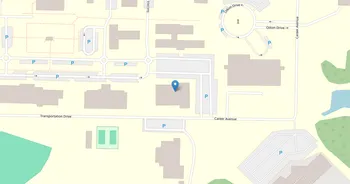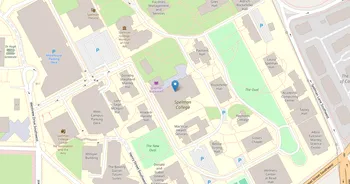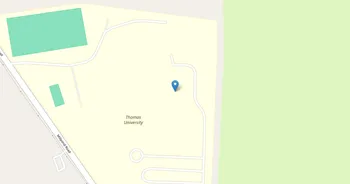Shorter University : Overview, Courses, Scholarships & Rankings
About Shorter University
Three rivers meet in Rome, and from a hill above them sits Shorter's red-brick campus with broad views and a calm, studious feel. The university is known for a liberal-arts core paired with solid work in the humanities, sciences, and professional fields. Faculty attention is the norm, and classes favor discussion and clear writing. Students use a well kept library, up-to-date labs, creative spaces, plus a student success hub for tutoring, advising, counseling, and career guidance.
Life on the Hill carries a friendly, faith-informed tone without losing its drive. Expect active clubs, arts ensembles, campus ministry, intramurals, and easy access to trails and rivers. The culture rewards pitching in, and service days and seasonal performances are familiar touchstones. Career prep stays practical with internships around the Rome area, faculty introductions to regional employers, and a responsive alumni network. Downtown coffee shops, galleries, and small businesses make it easy to plug in fast.
Key Institutional Details
Contact & Profile
Academic & Institutional
Academic Programs & Fields of Study
Shorter University offers 30 degree programs across 18 major academic fields, graduating approximately 354 students annually. The most popular fields by graduate volume are Business (3 programs, 129 graduates), Education (7 programs, 86 graduates), Kinesiology (1 programs, 29 graduates), Health (1 programs, 26 graduates) and Security & Safety (1 programs, 16 graduates). Explore program details, award levels, and graduate demographics below.
Business (3 programs, 129 graduates)
Business Administration, Marketing and Entrepreneurship
| Program Name | Graduates | Gender Distribution | Award Levels | CIP Code |
|---|---|---|---|---|
| Business Administration and Management | 112 |
|
Bachelor's
Master's
|
52.0201 |
| Accounting | 12 |
|
Bachelor's
Master's
|
52.0301 |
| Marketing Management | 5 |
|
Bachelor's
|
52.1401 |
Education (7 programs, 86 graduates)
Educational Sciences, Teaching Methods and Pedagogy
| Program Name | Graduates | Gender Distribution | Award Levels | CIP Code |
|---|---|---|---|---|
| Teacher Education and Professional Development | 45 |
|
Master's
|
13.1299 |
| Elementary Education | 16 |
|
Bachelor's
|
13.1202 |
| Elementary Special Education Teaching | 11 |
|
Bachelor's
|
13.1017 |
| Middle School Education and Teaching | 6 |
|
Bachelor's
|
13.1203 |
| History Teacher Education | 4 |
|
Bachelor's
|
13.1328 |
| Music Teacher Education | 3 |
|
Bachelor's
|
13.1312 |
| Mathematics Teacher Education | 1 |
|
Bachelor's
|
13.1311 |
Kinesiology (1 programs, 29 graduates)
Exercise Science, Sports Medicine and Physical Recreation
| Program Name | Graduates | Gender Distribution | Award Levels | CIP Code |
|---|---|---|---|---|
| Sport and Fitness Management | 29 |
|
Bachelor's
|
31.0504 |
Health (1 programs, 26 graduates)
Healthcare Professions, Medical Sciences and Clinical Practice
| Program Name | Graduates | Gender Distribution | Award Levels | CIP Code |
|---|---|---|---|---|
| Registered Nursing | 26 |
|
Bachelor's
|
51.3801 |
Security & Safety (1 programs, 16 graduates)
Emergency Management, Law Enforcement and Public Safety
| Program Name | Graduates | Gender Distribution | Award Levels | CIP Code |
|---|---|---|---|---|
| Criminal Justice and Safety Studies | 16 |
|
Bachelor's
|
43.0104 |
Biological Sciences (2 programs, 14 graduates)
Life Sciences, Biotechnology and Biomedical Research
| Program Name | Graduates | Gender Distribution | Award Levels | CIP Code |
|---|---|---|---|---|
| Biology and Biological Sciences | 8 |
|
Bachelor's
|
26.0101 |
| Biochemistry | 6 |
|
Bachelor's
|
26.0202 |
Psychology (1 programs, 13 graduates)
Psychological Sciences, Mental Health and Behavioral Studies
| Program Name | Graduates | Gender Distribution | Award Levels | CIP Code |
|---|---|---|---|---|
| General Psychology | 13 |
|
Bachelor's
|
42.0101 |
Liberal Arts (2 programs, 9 graduates)
Liberal Arts Education, General Studies and Humanities
| Program Name | Graduates | Gender Distribution | Award Levels | CIP Code |
|---|---|---|---|---|
| General Studies | 7 |
|
Associate's
|
24.0102 |
| Liberal Arts and Sciences | 2 |
|
Bachelor's
|
24.0101 |
Philosophy (1 programs, 9 graduates)
Philosophical Studies, Ethics and Religious Thought
| Program Name | Graduates | Gender Distribution | Award Levels | CIP Code |
|---|---|---|---|---|
| Religious Studies | 9 |
|
Bachelor's
|
38.0201 |
Communication (1 programs, 7 graduates)
Media Communications, Journalism and Public Relations
| Program Name | Graduates | Gender Distribution | Award Levels | CIP Code |
|---|---|---|---|---|
| Communication and Media Studies | 7 |
|
Bachelor's
|
09.0100 |
Admission Requirements & Test Scores
Comprehensive overview of admission criteria, standardized test score ranges, and application requirements for prospective students at Shorter University.
Application Requirements
Data based on IPEDS for 2022-2023 academic year. Test score ranges represent the middle 50% of admitted students (25th-75th percentile). Requirements may vary by program.
Tuition, Fees & Estimated Costs
Overview of tuition rates, housing, and other annual education expenses for undergraduate and graduate students
Financial Aid & Student Support
Summary of scholarships, grants, student loans, and financial aid statistics for undergraduate students
Student Success Metrics
Graduation rates and post-graduation earnings to help assess student outcomes and long-term value of education.
Loan Burden & Repayment Outcomes
Breakdown of loan repayment rates and student debt levels by income and dependency status.
Frequently Asked Questions
Find answers to the most common questions about Shorter University
How much does it cost to attend Shorter University?
The annual tuition at Shorter University is $24,044 for in-state students. When including room and board, books, and other expenses, the total estimated cost is approximately $37,188 for in-state students. Additional costs include room and board $9,784 (on) / $10,450 (off) and books and supplies $1,200.
Data based on IPEDS program completions for 2022-2023 academic year. Tuition and cost estimates are approximate and may not include all fees, personal expenses, or transportation costs.
What academic programs and degree levels does Shorter University offer?
Shorter University offers 30 academic programs across 18 major fields of study, with available degree levels: Certificate (1-2 yrs), Associate's, Bachelor's, Master's.
Most popular program areas include:
- Business Administration, Marketing and Entrepreneurship (3 programs)
- Educational Sciences, Teaching Methods and Pedagogy (7 programs)
- Exercise Science, Sports Medicine and Physical Recreation (1 programs)
- Healthcare Professions, Medical Sciences and Clinical Practice (1 programs)
- Emergency Management, Law Enforcement and Public Safety (1 programs)
Data based on IPEDS program completions for 2023-2024 academic year. Numbers reflect programs where students graduated, not all offered programs.
What is the acceptance rate for Shorter University?
Shorter University has an 96.9% acceptance rate and a 35.4% yield rate, making it moderately selective.
Admission statistics breakdown:
- Total applicants: 783
- Students admitted: 759
- Students enrolled: 269
Data based on IPEDS for 2022-2023 academic year. Admission statistics may vary by program and application cycle.
What financial aid and scholarships are available at Shorter University?
Shorter University provides financial aid to 20% of first-time, full-time students, with average grants of $18,168 and average loans of $6,441.
Average financial aid amounts by type:
- Pell grants: $5,579
- State/Local grants: $4,132
- Institutional grants: $12,495
- Federal loans: $5,374
The university supports 268 students with grants and 175 students with loans annually.
Data based on IPEDS for 2022-2023 academic year. Financial aid amounts and percentages may vary by program, enrollment status, and individual circumstances.
What is the average salary for Shorter University graduates?
Shorter University graduates earn a median salary of $41,860 after 6 years and $44,604 after 10 years.
The salary range 10 years after graduation spans from $27,477 (25th percentile) to $64,265 (75th percentile), with top earners reaching $85,400 (90th percentile).
Data based on IPEDS for 2022-2023 academic year. Salary data reflects graduates who received federal financial aid (approximately 60% of all graduates). Actual earnings may vary significantly based on program, location, and individual circumstances.
Related Universities




Found something useful? Help others discover it too! Share with friends, on social media, or save for later - every share helps someone find the information they need.